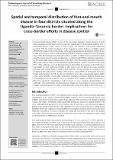| dc.description.abstract | Foot-and-mouth disease (FMD) is one of the major trans-boundary animal diseases in East Africa causing economic loss to farmers and other stakeholders in the livestock industry. Foot-and-mouth disease occurs widely in both Uganda and Tanzania with annual outbreaks recorded. With the recent introduction of the Progressive Control Pathway for FMD control (PCP-FMD) in eastern Africa, knowledge of the spatial and temporal distribution of FMD at the border area between Uganda and Tanzania is helpful in framing engagement with the initial stages of the PCP. Retrospective data collected between 2011 and 2016 from four districts located along the border areas of Uganda and Tanzania, recorded 23 and 59 FMD outbreaks, respectively, for the entire study period. Analysis showed that 46% of the 82 recorded outbreaks occurred in 20% of sub-counties and wards immediately neighbouring the Uganda-Tanzania border and 69.5% of the outbreaks occurred during the dry months. While the serotypes of the FMD virus responsible for most outbreaks reported in this region were not known, previous research reported South African Territory (SAT) 1, SAT 2 and O to be the serotypes in circulation. The results from this study provide evidence of the endemic status of FMD on the Uganda-Tanzania border and emphasise that the border area should be given due consideration during FMD control drives and that cross-border coordination should be prioritised. With the limited data on circulating serotypes in this area, there is a need for more vigilance on FMD case detection, laboratory diagnostic confirmation and provision of more complete documentation of outbreaks. This work further recommends more studies on cross-border livestock movement coupled with phylogenetics in order to understand the spread of the FMD in the border area. | en_US |

